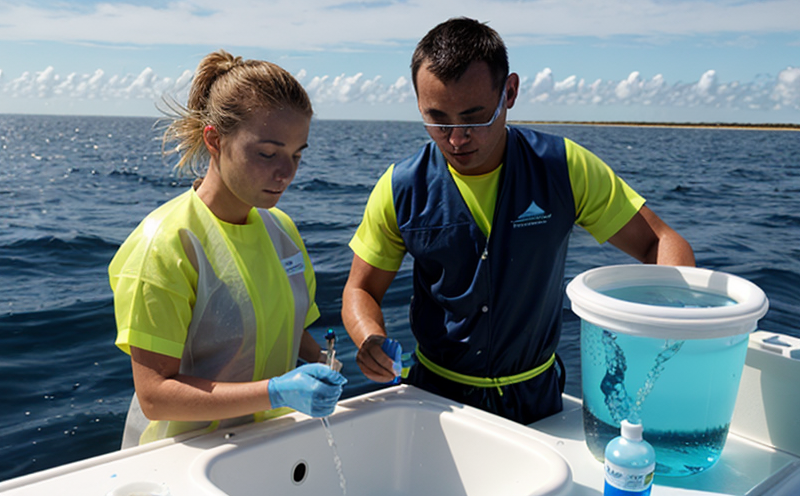ASTM D5812 Copper Test in Seawater
The ASTM D5812 copper test is a critical procedure used to measure copper content in seawater. This test is essential for ensuring compliance with environmental regulations and safety standards, particularly in coastal areas where industrial activities or natural processes may introduce copper into the marine environment.
Copper plays a significant role in various industries such as electronics, construction, and water treatment. However, excessive levels of copper can be toxic to aquatic life, affecting ecosystems and human health through seafood consumption. Therefore, monitoring copper concentrations is crucial for maintaining environmental quality and public safety.
The ASTM D5812 procedure involves the following steps:
- Sample Collection: Seawater samples are collected using appropriate sampling techniques to ensure representativeness. Properly labeled containers should be used, avoiding contamination by copper residues from the container itself.
- Sampling Preservation: Samples are preserved immediately upon collection using concentrated nitric acid (HNO3) or EDTA solutions to prevent changes in copper concentration due to biological activity or hydrolysis.
- Sample Analysis: Analyzed following standard laboratory protocols, including digestion and colorimetric determination of copper content. This step ensures accurate measurement without interference from other metals present in seawater.
- Data Interpretation: Results are compared against established standards to determine compliance levels or potential risks associated with elevated copper concentrations.
Our laboratory adheres strictly to ASTM D5812 guidelines, ensuring reliable and consistent results that meet industry expectations. By leveraging advanced analytical techniques and experienced personnel, we deliver precise measurements essential for effective decision-making in environmental management practices.
Benefits
The ASTM D5812 copper test offers numerous advantages for organizations involved in marine operations or those responsible for protecting coastal environments. Here are some key benefits:
- Regulatory Compliance: Ensures adherence to international standards such as ISO 17025, enhancing credibility and trustworthiness.
- Precision Measurement: Provides accurate data on copper content, aiding in informed decisions regarding operational practices or necessary corrective actions.
- Environmental Protection: Helps identify sources of pollution early, allowing for proactive measures to mitigate adverse effects on marine life and human health.
- Data Integrity: Maintains consistent quality across multiple tests conducted over time, facilitating trend analysis and long-term monitoring efforts.
- Risk Management: Enables identification of potential risks associated with elevated copper levels, enabling timely interventions to prevent harm.
- Confidence in Results: Offers peace of mind knowing that all analyses comply with rigorous quality control measures established by recognized authorities like ASTM and ISO.
- Economic Efficiency: By preventing costly mistakes related to non-compliance or environmental damage, this service contributes significantly towards operational efficiency and cost savings.
These benefits underscore the importance of regular monitoring through proper testing methods like ASTM D5812. Organizations can rely on our expertise to safeguard their reputation while contributing positively to sustainable development goals.
Customer Impact and Satisfaction
- Enhanced Reputation: Compliance with international standards strengthens clients' positions in competitive markets, fostering trust among stakeholders.
- Informed Decision-Making: Accurate data enables better strategic planning for future projects or initiatives aimed at improving environmental performance.
- Improved Operations: Early detection of issues allows businesses to implement corrective measures promptly, avoiding disruptions and associated costs.
- Safety Assurance: Ensures that products meet safety requirements set forth by regulatory bodies, protecting end users from potential hazards.
- Customer Loyalty: Reliable services build long-term relationships based on reliability and integrity, encouraging repeat business and referrals.
- Competitive Advantage: Demonstrating adherence to best practices can differentiate clients from competitors in terms of quality assurance and sustainability commitment.
Our dedication to excellence translates into satisfied customers who appreciate the value-added services we provide. By choosing us, organizations not only gain access to world-class facilities but also benefit from expert guidance tailored specifically to their needs.
Use Cases and Application Examples
The ASTM D5812 copper test finds application in various scenarios where monitoring seawater quality is crucial. Below are some typical use cases:
- Industrial Operations: Companies engaged in offshore drilling, shipbuilding, or other activities near coastal areas need to ensure that their operations do not contribute to increased copper levels in the surrounding environment.
- Pollution Control: Authorities responsible for enforcing environmental laws can use this test to monitor compliance with permissible limits of copper discharge into marine waters.
- Research Institutions: Academic institutions conducting research on oceanic ecosystems might utilize ASTM D5812 results when investigating the impact of anthropogenic activities on marine life.
- Environmental NGOs: Non-profit organizations focusing on environmental protection often rely on rigorous testing methods to gather evidence supporting their advocacy efforts.
- Tourism Industry: Facilities providing recreational activities in coastal regions can use these tests to maintain water quality standards expected by tourists, thereby enhancing customer satisfaction and loyalty.
- Water Treatment Plants: Operators managing facilities treating seawater for potable purposes must continuously monitor copper levels to ensure safe drinking water supply while minimizing contamination risks.
In each case, accurate measurement of copper content is vital for achieving desired outcomes. Our laboratory ensures that clients receive reliable and actionable insights based on scientifically sound testing procedures.





